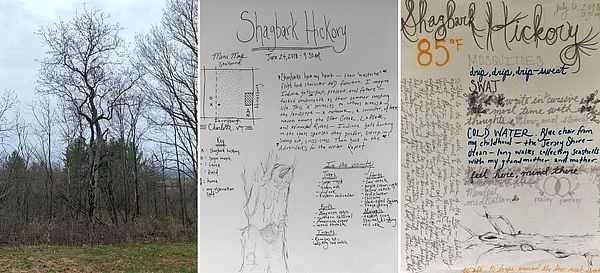A sit spot is an outdoor site where you can go to slow down, soak up what’s around you, and appreciate nature. It is a location in your backyard or close to home—this is not a get-in-your-car activity—where you can observe changes in the natural world over time. With stay-close-to-home guidance in place, this activity can be a welcome refuge from the current uncertainty. Visit your sit spot on a timeline that works for you: daily, every other day, or weekly. We suggest returning to your sit spot at the same time of day, so you can intimately learn the patterns and rhythms of your site. This practice can take place year-round, but is especially exciting in spring, when buds burst, amphibians lay eggs, and songbirds migrate.
The 101 Guide to Sit Spots
Where?
Your sit spot can be a special corner of your yard, a porch, your front stoop, or a space around your neighborhood. If you’re unable to get outside, open a window to connect with the natural world. Pick a place that is easy to get to, where you can sit quietly and comfortably without distraction for an extended period of time.
How long?
You can visit your sit spot for five minutes or 30 minutes (or longer!). We recommend that you give yourself a window of time to “settle in” to your sit spot and separate from what you were doing earlier and what you need to do later. Visiting the same spot can reveal new discoveries:
- “I hear a downy woodpecker in my backyard!”
- “I notice a maple tree in bloom over my head.”
- “Wow, I feel more grounded and relaxed after five days of visiting this spot.”
Who?
This activity is for anyone. Ideally, it is a solo activity, but it can become a family activity if you give one another ample space (25 yards apart or more). Young children will need a buddy.
What do I bring?
There is no need to bring tools with you; however, you might consider:
- Something to sit on
- A notebook, journal, or scrap paper and clipboard for notes or sketching
- Writing, drawing, or painting utensils
- Binoculars to view things at a distance
- A hand lens to observe things up close
Remember to dress for the elements: apply sunscreen, wear a hat, and pack a rain jacket depending on the day. If heading out for an extended time, bring water and a snack. Before you venture out, please take a moment to silence your cell phone.
Prompts
When an activity is new, it can be hard to get into a groove, so we put together a list of prompts to help you get started:
- There is value in sitting outside in solitude. Use this opportunity to take deep breaths and expand your awareness of nature.
- Close your eyes. What do you hear? What do you smell?
- If you’d like to record observations, note your name, the date and time, the temperature, and general weather conditions.
- Draw a map of your sit spot and include the following:
- Name
- Date
- Title
- Legend
- Scale indicator: helps a reader determine distance on a map
- Orientation: which way is north?
- Create a _______ of or about your site.
- Poem
- Short story
- Sketch
- Song
- Generate a bird list, wildlife list, or plant list from your sit spot.
- Consider the question: When precipitation falls on the surface area of my sit spot, where does it travel?
- Follow the phenology of an herbaceous plant, shrub, or tree.
- When do you see budburst, all leaves, flowers, and fruits?
Most importantly, have fun and let your sense of wonder guide you.
